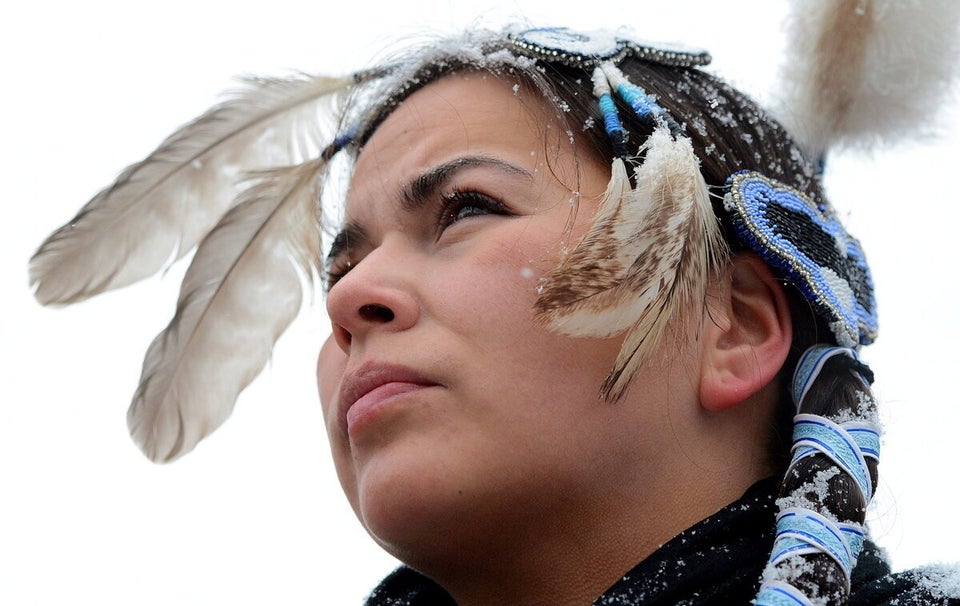
While the federal government adjourns for summer break, they would be hardpressed to ignore headlines this week about their failure to ensure Indigenous peoples in Canada are thriving. A report released by the Canadian Centre for Policy Alternatives and Save the Children illuminates a stark reality for status First Nations populations: 50% of children are living in poverty. This came after a second report by the Canadian Human Rights Commission outlined how far behind Aboriginal populations are in regards to income and employment. All in all, the picture is bleak.
The first report, "Poverty or Prosperity: Indigenous Children in Canada" mentioned that no other OECD country comes close to the 50% child poverty rate experienced by status First Nations -- the next in line is Turkey with 25%. And in Manitoba and Saskatchewan the child poverty rate actually gets worse with First Nation's child poverty rates of above 60%.
Beyond these initial startling statistics the report revealed other vulnerable groups disproportionately struggling with poverty: 22% of children, 33% of immigrant children, and 37% of Inuit, Metis and non-status First Nations. This is compared to a 12% child poverty rate for all remaining children in Canada, and an overall child poverty of 17%. Clearly Canada has nothing to brag about in this regard.
The poverty uses data from the 2006 census and the internationally accepted measurement tool the Low Income Measure (after-tax), which places the poverty line at half the median income. The report concludes that the poverty rates are the result of poor federal investment in programs and supports for status First Nations. The federal government is responsible for all health care, income supports and education on reserves.
What Poverty or Prosperity also noted was that the problem of poverty for status First Nations peoples is not just one of income, but also a lack of services. While increased income supports are needed (income supports for status First Nations have been capped at 2% since 1996 without allowance for population growth or rising prices), the report states that supporting Aboriginal entrepreneurs, ensuring better education on and off reserve, connecting First Nations peoples with jobs in the resource sector, and allowing for self-government are also needed to address the issue.
The total cost of investment is estimated to be $1 billion for indigenous children, or $7.5 billion for all children in Canada. While that cost may seem high, the return on investment would exceed this amount. The report quotes the 1996 Royal Commission on Aboriginal Peoples that stated that lost productivity and remedial costs also equated to $7.5 billion -- but that was over a decade ago.
The second blow this week was delivered by the Canadian Human Rights Commission (CHRC) whose own research confirms that Aboriginal men and women (status First Nations, Métis, Inuit) are facing greater challenges than the non-Aboriginal population. Titled, "Report on Equality Rights of Aboriginal People", CHRC highlights that across the board Aboriginal persons are lagging behind the rest of the population in regards to the economic and social rights of employment, well-being, education and housing
Part of the reason that there is such high child poverty rate is that educational attainment and employment readiness and opportunities are problematic. Aboriginal adults less likely to have a post-secondary degree, and they are earning less than non-Aboriginal persons. Aboriginal men and woman also have a lower employment rate, and many equate this problem to not having adequate education or skills. General poverty rates are also higher and the likelihood that individuals will stay in poverty for more than four years is much greater.
This is not a recipe for success.
With "deep concern" about the state of Indigenous peoples Canada, the United Nations Special Rapporteur on the Rights of Indigenous Peoples, James Anaya, has repeatedly reached out to the Canadian government. In response to the housing crisis in Attawapiskat in 2011 he contacted the Canadian government and noted that while Canada is a developed nation, Indigenous peoples face higher rates of poverty and poorer health and educational outcomes than the rest of the population. Mr. Anaya was mocked by the federal government who called his statements a 'publicity stunt'.
Until recently, Mr. Anaya was not granted access to come to Canada on an official visit to assess the reality on the ground in Indigenous communities. He is now set to visit Canada before his term as Special Rapporteur concludes in 2014.
Hardly a publicity stunt, what these reports confirm is that Mr. Anaya's concerns are well-founded and the poverty conditions experienced by First Nations peoples are a stain on Canada's human rights record.
